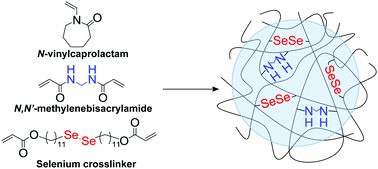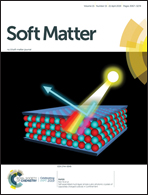Functional selenium modified microgels: temperature-induced phase transitions and network morphology†
Abstract
Microgels that host selenium and mimic the structure of the enzyme glutathione peroxidase are of great interest for biotechnological and catalytic applications. For this purpose selenium-functionalized thermoresponsive poly(N-vinylcaprolactam) (PVCL) microgels with cleavable diselenide crosslinks have been investigated. Thermodynamic and morphological parameters characterizing the temperature-induced phase transitions of dual crosslinked PVCL microgels were obtained using dynamic light scattering (DLS), 1H high-resolution magic-angle sample-spinning (MAS) NMR spectroscopy, and transverse magnetization (T2) NMR relaxometry. Quantities obtained from Flory–Rehner theory, a two-state model and Boltzmann sigmoidal function were used to relate the phase transitions of the dual crosslinked microgels to the transition temperature, entropy, temperature width of the phase transition, Flory interaction parameters, average number of strands, polymer volume fraction of the collapsed microgels, core–corona fractions and chain dynamics. The morphology of the selenium modified microgels after the oxidation and reduction processes was investigated by 1H T2 NMR and further correlated with the crosslink density.



 Please wait while we load your content...
Please wait while we load your content...